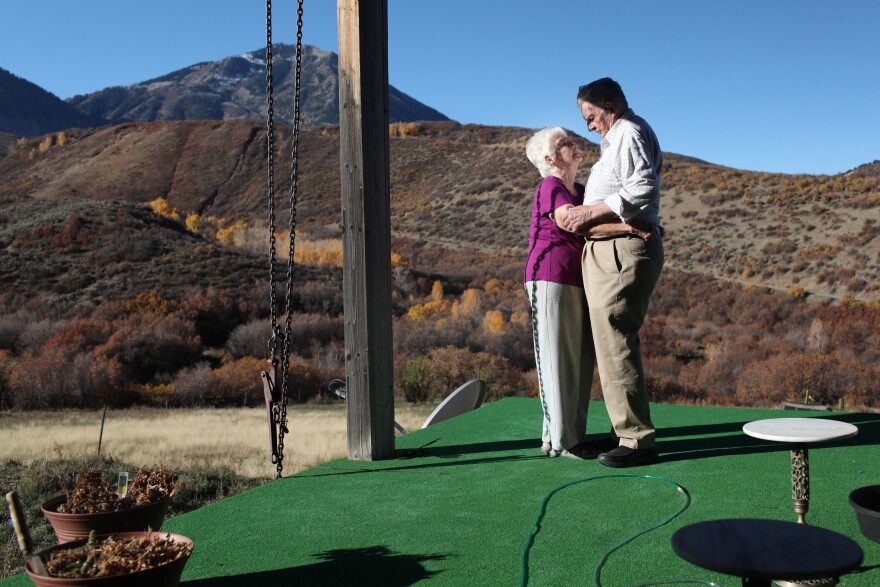Dallas and June Harding are regulars on the Almanac, but most of their daily weather observations you'll see there date back to the late 1980s.
That's because those entires were transcribed from the journals June started keeping in 1985, when she and Dallas moved to their current home at the Harding Ranch near the base of Coal Mountain. I recently paid the Hardings a visit to talk about how they got involved with the iSeeChange project, and how journaling has played a role in their lives and the lives of previous generations.
Dogs and cats greet me as I get to the door of the Harding’s house, situated on a serene, calming piece of property with stunning close-up views of the nearby mountains. Dallas points out the nearby mountains – Gunnison, Coal and Hoodoo Gap.

Dallas' family homesteaded this ranch in 1904, and the land's been in the family ever since. The Hardings have long a history here with rich ties to the community, but June still insists she's not what you'd call an "old timer."
“I’ve only been here 61 years,” she says. “So I’m really a newcomer. I don’t know all this old-timey stuff.”
June's journal observations of the weather are a key part of what the Almanac's all about - sharing and comparing observations on how wildly different and similar the environment can be from year to year.
One recent example: the week Cedar Keshetposted pictures of the season's first snow on Coal Mountain, June's journal from 1989 says it was still 88 degrees out. And if you look back to her entries from just a week before that in 1989, it was 30 degrees outside their house and snow was on Gunnison.
Looking back at June's journals can tell us a lot about the history of this country. It's easy to say this year's been a wild weather year in Colorado. Historic rains in the middle of a historic drought alone will tell you that.
But without those firsthand accounts from decades past, it's hard to tell just how wild it was, or whether these extremes were just par the course for the West. Or at least, the journals are more fun than graphs.
June calls the journals "just the facts,” but they aren't just for scientists or weather geeks, and in fact, the Hardings didn't start writing them just to keep track of the rain.
“Really the reason we got started writing ‘em is there was some guys doing some poaching up here,” says Dallas. The Game Warden would come by their house, asking questions.
“He wanted facts in order to nail these guys that were up here killing everything they could find,” says June. So like some sort of frontier-style legal defense, the Harding's journals were their way of showing the Game Warden they weren't poachers. They were too busy making apple sauce.
But June soon got hooked on journaling, and now says she’s glad she did.
“Oh they have been so valuable,” she says. “We’ve looked back in those journals many many times, to help us remember something.”
Journaling in the Harding family goes back farther than June and Dallas though. Dallas shows me one of his mother's diaries from 1938-1942. It comes from a time when the written word was perhaps more important to daily life than it is today, when jotting down a day’s work was just as common as checking your email.
June says when she reads through those diaries, she's impressed with just how hard times really were.
“They talk about picking peas,” she says. “They picked peas and picked peas, and sometimes that’s all they had to eat.”
Weather was a big part of the elder Mrs. Harding's journals as well - Dallas reads an end-of-the-year entry from 1940, where his mother says that year saw the “worst flood we’ve ever had,” a lot of erosion damage and more sheep arriving on the range.
Bits of wisdom are scattered throughout the diary. In one entry, Mrs. Harding reminds herself to jot down the weather for the first twelve days of the new year. A local banker told her that was a good way to predict the weather for the next eight months.
I finally ask June what her reaction was when KVNF approached her about putting all these old journals online.
“What??” she remembers saying. “They’re only just information for us. Yea it was a surprise.”
“You know, we really do want to leave the heritage of our country here,” June says. “You young people are moving in and it’s really flattering to us that you care enough about our area that you want to know about it.”
June says she gets more excited about that than the journals themselves.
I asked June before I left what it's like seeing those journals on the internet, cemented in history, used as a reference for people across the region as they’re watching the seasons change.
“I think it’s wonderful,” she says. “I’m fine with letting the world know what it was like.”
And when she says “what it was like,” she's not just talking about the weather. According to June, if you read back through her journals, or Dallas' mother's, or any of the older generations, you’ll find a theme.
“Life was hard,” she says. “It’s getting easier all the time, but life has been really hard up here.”





